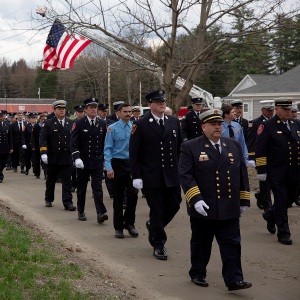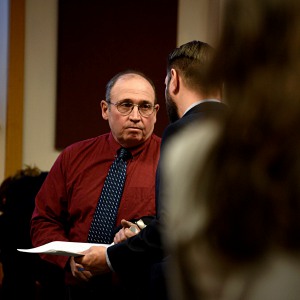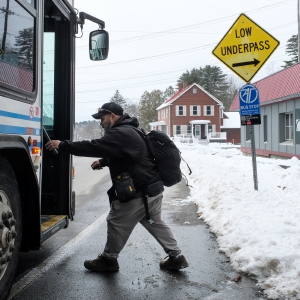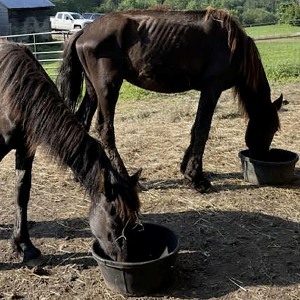Tropical Storm Irene, 10 years later: At South Royalton farm, scars have faded but memories have not
| Published: 08-27-2021 9:39 PM |
SOUTH ROYALTON — The White River carves a sharp, L-shaped bend that hugs the low-lying fields where Geo Honigford grows a varied bounty of organic vegetables.
These days, the river seems safely nestled in its channel. Honigford, though, remembers when Tropical Storm Irene arrived in all its fury on Aug. 28, 2011, driving the White River over its banks and drowning his fields.
“It just went straight across my field, because that’s the path of least resistance,” Honigford said. “So the main current took off across my field.”
A decade ago this week, Tropical Storm Irene delivered wind and flooding damage up the East Coast before stalling between the Hudson and Connecticut river valleys. It dumped as much as 11 inches of rain in less than 18 hours.
As the storm lingered, 8 inches of rain fell on parts of the Upper Valley. Because Irene came close on the heels of an earlier heavy rain, the region’s already-thin layer of topsoil was too saturated to absorb the deluge that thundered down the slopes of the Green Mountains.
Within hours, rivers throughout the region erased their banks, and paved roads became fast-flowing tributaries.
Honigford, a former social studies and science teacher, has farmed on these 37 acres since 1995. With tanned skin and a scruffy brown beard, he looks younger than his 58 years. He named his farm Hurricane Flats after he spied the moniker in a history of Royalton. The name evoked the winds that often sped across his field. Years later, it would be prove sadly prescient, when his farm became one of hundreds in the state damaged by Irene’s deluge.
On an overcast day this summer, Honigford gave a tour of his farm and sifted through his memories of the storm. In the days before, he was bracing for heavy winds. But on the Sunday Irene arrived, it was rain — falling relentlessly in heavy droplets — that posed the grave threat.
Article continues after...
Yesterday's Most Read Articles
 Crowd turns out to honor late Ascutney Fire Chief Darrin Spaulding
Crowd turns out to honor late Ascutney Fire Chief Darrin Spaulding
 Former principal of South Royalton School released from prison
Former principal of South Royalton School released from prison
 Pick a sport and Pete DePalo’s has probably officiated it over the past 40-plus years
Pick a sport and Pete DePalo’s has probably officiated it over the past 40-plus years
 Upper Valley residents among advocates for NH aid-in-dying bill
Upper Valley residents among advocates for NH aid-in-dying bill
 NH man convicted of killing daughter, 5, ordered to be at sentencing after skipping trial
NH man convicted of killing daughter, 5, ordered to be at sentencing after skipping trial
Only when the White River began to spill over its banks and invade his fields in the early afternoon did he realize he was in the midst of a full-blown crisis.
He ran for his tractor to pull his equipment to higher ground. He worked fast, but the water rose faster. He didn’t have time to save the tedder, a piece of farm equipment that aerates cut hay.
“It was literally coming up an inch a minute,” Honigford said. “So you could watch it. ... You’d be in a dry area and it would cover your feet, just like a small wave just rolling across.”
Honigford and farmhand Mark Edsell waded into the rising water with utility knives to slash the plastic walls of his two greenhouses in an effort to keep the $9,000 frames from being swept away. Soon, however, they were forced to retreat to the farmhouse on high ground.
Unable to sleep, Honigford continued to check on the water. It reached its highest level around 11 p.m., submerging the fields that he had planted months earlier with melons, sweet potatoes, pumpkins and sweet corn. The river crept back toward its banks during the night.
In the wake of Irene, agricultural agencies faced a monumental task.
According to the USDA’s Farm Service Agency in Vermont, Hurricane Flats was one of 476 farms in the state that Irene hit. The storm destroyed 7,200 acres of hay, 6,000 acres of corn, 1,750 acres of pasture and 600 acres of fruit and vegetables, the agency reported.
Some farmers saw rivers carry away chunks of their land. Others saw the water strip away their soil and expose the gravel beds below. All told, the Farm Service Agency’s unofficial estimate for farmers’ economic losses approached $20 million.
Honigford woke just after dawn the day after the storm. By 8 a.m, the White River was back in its banks, leaving behind a vista of destruction.
Two gaping holes scarred the riverbank. Water had lifted a pumpkin crop en masse and lodged the fruit in the branches of his neighbors’ trees.
Heaps of silt — mineral-heavy sludge — cloaked his fertile soil. Wire farm fence was wound into coiled chaos. Trees that had once enforced the boundaries of the river lay on the ground, their tangled root heads pulled from the soil.
An irrigation system with its two power panels and two pumps, each worth thousands of dollars, lay in ruin.
As Honigford put it, “Hurricane Flats” had become “Hurricane Flattened.”
They had managed to save the greenhouses, with pieces of torn plastic clinging to the still-standing frames. A few particularly stubborn tomatoes still clung to their vines.
Two friends, Greg and Mary Russ, drove from their home in Royalton to help when the roads reopened after they couldn’t reach Honigford on the phone.
Mary Russ helped Honigford’s wife, Sharon O’Connor, and their two teenage daughters, Emma and Cora, scrub silt-coated vegetables while her husband assessed the damage along the riverbank.
“It was pretty stunning, and they were still shocked,” Greg Russ said. “They thought they could save some of the harvest; all the root vegetables were in the greenhouses drying out.”
Soon, Honigford found that their time and energy had been wasted. After consulting the FDA, the Vermont Agency of Agriculture announced that the flood water was contaminated with sewage and hazardous microorganisms.
“Every vegetable out here, we couldn’t sell,” Honigford said. “The state said it’s all contaminated: ‘You can’t sell, and you can’t sell any produce grown off contaminated land for two months.’ ... We were done. Our season was over.”
And so the crops would rot in place.
Honigford still had some potatoes that had been stored on high ground and were untouched by the floodwaters. But he couldn’t bring himself to go to the farmers market in Norwich. Normally, he mans a double-tent booth where his vegetables and signature Ruby Red Popcorn consistently attract a line.
After Irene, all he could stock was potatoes and T-shirts. Some friends took over the booth and other farmers let him take over their potato orders.
Looking back, Honigford said he knew he’d clean up his farm and plant again no matter what.
He also understood the location that helped Hurricane Flats be successful also put it at risk.
“The best farmland of the world is next to volcanoes and in river bottoms,” Honigford said. “That’s the best farmland in the world — so I have great farmland. That’s the price I pay.”
He’d grown interested in farming while helping to grow a rice crop while serving in the Peace Corps in Sierra Leone, which is also where he met O’Connor. Her work as a research scientist at Dartmouth College provides stable income to smooth out the ebbs and flows of the agriculture business.
The family lives in a shaded light-green farmhouse near a red barn with a wide gambrel roof. Although Irene submerged the fields, the house stayed safe through the storm. In the 18th century, the first settlers of Hurricane Flats built the home on a small hill that rises from the fertile floodplain.
“The old-timers ... they knew this river was going to flood. Today, we don’t seem to remember this,” Honigford said.
He pointed toward rebuilt homes neighboring his farm. They are situated low in fields, vulnerable to the river’s fury.
In the days after Irene, Honigford left his wrecked farm behind and insisted on helping his neighbors.
“Those guys had greater needs than me — that was their house. I just lost a business that we couldn’t do anything with anyway,” he said.
Honigford spent all the time he could away from Hurricane Flats.
“The only way I could keep functioning was to not be here. When I came here at night, I was depressed. But when I was out there during the day, I was OK,” Honigford recalled. “At least, I thought I was OK; maybe I wasn’t.”
His 13-year-old daughter, Cora, and her soccer team came to sling buckets of mud out of a basement of a neighboring home.
“I was just managing people — all these people were muddy and filthy. I was perfectly clean,” he said.
He remembers Cora making sure to give him a big hug so that he could get his share of mud.
“She felt pretty good about that actually,” he said, still laughing at the memory.
By the following Friday, five days after Irene struck, all the damaged houses had been gutted, and Honigford joined his neighbors on the town green to let loose at a party complete with kegs of beer and live music.
Meanwhile, Hurricane Flats remained a wreck.
Honigford credits Jennifer Megyesi, of Fat Rooster Farm, with convincing him to accept the same help he had offered others.
“She pulled me aside and said, ‘It’s your turn now. We’re going to help you,’ ” Honigford said.
“It’s really hard to ask for help. I mean it’s impossible to ask for help. She just said, ‘We’re going to do this. This is when we’re going to do it. And now shut up and deal with it.’ ... She needed to do that. I wasn’t going to ask on my own.”
On Sept. 8, nearly two weeks after Irene, more than 100 volunteers arrived at Hurricane Flats.
They rolled up the wire fencing, dug out the irrigation equipment and pulled up the black plastic that had protected a sweet potato crop. The plastic lay shredded under a heavy layer of silt — it was a “nasty job,” Honigford recalled.
He audibly scoffed when asked how long it would have taken him on his own.
“I would have gotten her done,” he said, “but it would have taken all fall, and it would have been a miserable job.”
Honigford had no crop insurance, and he never sought out help from FEMA. Although he may have been eligible for grants with the Vermont Department of Agriculture or the Natural Resource Conservation Service, he refused to wait to get his expenses approved before he started cleaning up his farm.
Overwhelmed with requests, state agencies struggled to act quickly. He could not afford to lose another growing season.
“At the pace they were moving at, it was going to go into the next season. ... You can’t buy the new things and then retroactively they pay you back. You have to get approved, and then buy them,” Honigford said.
A decade later, Honigford still doesn’t have crop insurance. The available policies require meticulous record-keeping. According to his own calculations, he said that spending an hour a day on the necessary paperwork would cost him more than one Irene-level catastrophe every 16 years.
Honigford is hardly the only farmer to escew insurance, according to Lorraine Merrill, who served as New Hampshire’s agriculture commissioner during Irene.
“Organic or not organic, I’ve known quite a few farmers who have tried crop insurance and gotten discouraged and gotten out of it,” she said. “Some have made it part of their regular risk management.”
She said that few farmers in New England can find a crop insurance program that works well for them. The Federal Crop Insurance Corp., a government-owned corporation managed by FEMA and the USDA, structures its policies around the large commodity crops of the Midwest, not the smaller, diversified farms of New England.
Insurance policies designed to compensate farmers at the low commodity prices standard in other regions don’t do much to help New England farmers recover after a disaster.
“Our vegetable and fruit growing is much more geared toward direct marketing to consumers. So prices farmers get are significantly higher, which is the only way they can cover the higher costs of growing in New England. Everything — labor, housing, fuel, grains, all transported to this corner of the country — everything costs more here,” Merrill said.
Still, Honigford was able to scrape $15,000 together from a range of grants from organizations including NOFA Vermont, the Vermont Community Foundation and a fund started by townspeople.
Honigford also saved thousands of dollars when he broke with most other farmers and decided to let the silt stay where it had fallen.
“I left it and it became my new soil,” he said. “The new deposits came without organic particles — they had nothing in. It was like washed clean, which is just, they had no weeds, no weed seeds, no organic particles.”
As Honigford saw it, thousands of years of floods had left him with some of the most fertile soil in the region. He would let nature take its course even if that meant the soil was harder to work with in the short term.
He had enough to do without meticulously scraping off tons of silt. The two gaping holes in the riverbank were vulnerabilities where the river might try to etch a channel through his fields. The town, meanwhile, had to remove the silt from its athletic fields, so Honigford claimed it and piled it into the holes.
“I spent eight hours a day just on my tractor just pushing first into the hole, into the hole, into the hole,” Honigford said. The fine-grained silt was vulnerable to erosion, so more work needed to be done.
Bob Gubernick, a watershed restoration geologist at the Forest Service willing to lend his expertise, helped the White River Partnership, a nonprofit headed by the Russes, make the riverbank more resilient than ever.
They used the uprooted trees and driftwood that the flood had left in its wake to build a stronger riverbank at its weakest points. Climate scientists predict more heavy, intense rain in New England, and they had to prepare for the possibility of another Irene.
“So basically, the root balls caught all the sediment and built the bank up. The river built its own bank out here,” Honigford said.
Willows and weedy, fast-growing box elders took root on the bank, their roots penning the river into its L-shaped bed. Unlike riprap, the wood and vegetation cool the water and slow it down, pulling out the force that pummeled Hurricane Flats 10 years ago.
It’s a battle of wills between water and soil that has gone on for eons, he explained.
“Really, what the river is trying to do is cut a new channel. That’s too much work for it now,” he said. “It’s natural for the river to want to do it. We all live here, so we don’t want the river to do it.”
Looking out at the vibrant farm 10 years later, it’s hard to imagine that it had been inundated with 10 feet of water. Honigford, though, made sure people wouldn’t forget.
A wooden sign reaches above the ground and announces, “IRENE high water mark,” with two black arrows gesturing up to a black bar painted on the top of the sign.
Irene, though, has left its own more subtle signs.
If you look closely at Honigford’s rows of corn, you’ll notice a slight dip. The silt did not fall in an even layer, and where it is thickest, the crops still have to fight a little harder to grow.
Claire Potter is a Report for America corps member. She can be reached at cpotter@vnews.com or 603-727- 3242.

 Upper Valley winter shelters kept dozens warm and dry
Upper Valley winter shelters kept dozens warm and dry Owner of Friesian horse facility ordered to pay care costs for seized animals
Owner of Friesian horse facility ordered to pay care costs for seized animals
